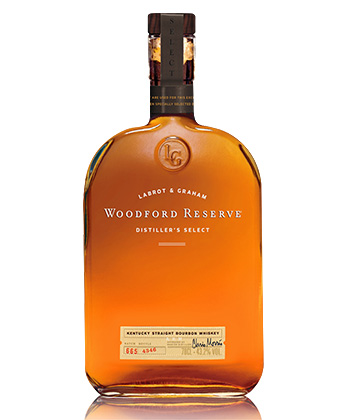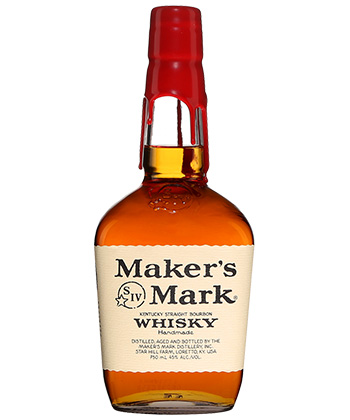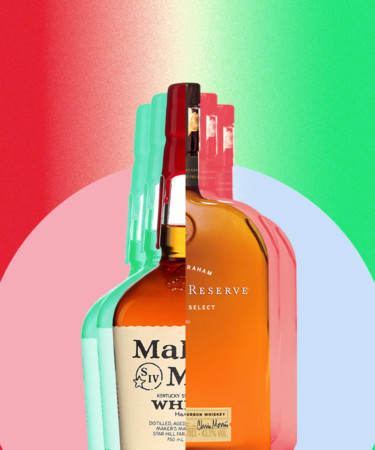America’s demand for bourbon shows no signs of slowing, particularly for beloved brands Woodford Reserve and Maker’s Mark. Considered to be classics in the category, both companies are making the most of the category’s surge in popularity.
According to The Spirits Business, in 2020, Woodford Reserve surpassed sales of 1 million cases for the first time in its history, increasing 19 percent. And based on data sourced from Drizly, Forbes reported that Maker’s Mark and Woodford Reserve came in as the second and third best-selling bourbons in the U.S.
From Maker’s trademark red wax–topped bottle to Woodford’s elegant vessel, keep reading to learn more about what sets these two iconic brands apart.
Origin
In 1953, Bill Samuels Sr., along with his wife Margie, founded Maker’s Mark in the Kentucky town of Loretto. As a sixth-generation distiller, Samuels set out to make a whiskey he actually enjoyed, with less bite than his family’s 170-year-old bourbon recipe — which he dramatically torched in a bucket fire. To come up with a new recipe, the Samuels tested batches of grain by baking them into bread, which led to a winning formula featuring red winter wheat.

Woodford Reserve has been produced since 1996 at Kentucky’s Labrot and Graham Distillery, one of the oldest working distilleries in the state. Once known as the Oscar Pepper Distillery, the facility has featured a rotating cast of operators since its inception in the early 19th century.
In 1941, Brown-Forman Corporation, the company that launched Woodford Reserve, acquired the Oscar Pepper Distillery. Although it would eventually abandon the enterprise and sell the distillery to a local farmer, a desire to produce small- batch bourbon would prompt Brown-Forman to repurchase the distillery in 1993.
Production
Jonah Dill-D’ascoli, the bar director at Rosemary’s East in New York, uses a unique analogy when considering the mash bill of American whiskey: “Think of the difference between a PB&J on rye, versus whole wheat, versus corn bread. All those sandwiches would be distinctly different.”
The difference can be clearly seen in the respective ingredient blends, as Dill-D’ascoli notes when he breaks down the brand’s mash bill: Woodford Reserve contains 72 percent corn, 18 percent rye, and 12 percent barley, whereas Maker’s Mark “is reported to be 70 percent corn, 16 percent wheat (namely red winter wheat), and 14 percent barley.”
“You begin to see the differences immediately; think about a piece of rye toast, which is bright, dry, and spicy versus a piece of wheat toast being soft, a little sweet, and chewy,” he adds.
Flavor
VinePair’s tasting of Maker’s entry-level bottle found “toasted oak and vanilla” on the nose and palate, with a “nice full-bodied texture.” Bottled at 90 proof, the versatile whiskey was declared a good sipping option, though preferred for use in cocktails.
For Brewer Richardson, the bar manager at Repeal Bourbon & Burgers in Virginia Beach, the brands offer very different profiles. “Maker’s Mark uses no rye and a high percentage of wheat to produce a heavily wheated bourbon. The abundance of wheat and the absence of rye give Maker’s great honey notes,” he says.
When it comes to Woodford Reserve Distiller’s Select, which comes in slightly higher at 90.4 proof, Richardson points to the inclusion of rye as a prominent factor: “The rye gives it a slightly spicier and more complex flavor overall.”

Cocktails
Bourbon’s approachability and nuance make it a popular ingredient in bartender creations. In fact, it’s rare to find a cocktail menu that doesn’t include America’s native spirit in at least one concoction.
Matthew Olson, the restaurant and bar manager of Sabroso+Sorbo at The Notary Hotel in Philadelphia, reserves each brand for a specific cadre of cocktails. “I prefer Maker’s if I am making a bourbon and ginger or Coke,” he says. “I would use Woodford in my Old Fashioned or Manhattans.”
For Richardson, Maker’s is a go-to when shaking up citrus-forward cocktails: “That slight sweetness balances citrus so well.” But when using Woodford Reserve, he opts for Wisconsin-style Old Fashioneds — a staple at his bar: “The touch of rye spice really complements the fruit and sugar of the cocktail.”
Why the Pros Like Each
Richardson sees value in both brands’ flagship expressions and admits that picking a clear winner is a difficult task. “These are some of the first bottles that I reach for when a guest tells me that they’re new to bourbon and ask what they should try. On the other hand, both are going to be bourbons that whiskey enthusiasts won’t ever turn down,” he says. “Both distilleries have had a huge impact on the explosive growth of bourbon we’ve seen in the last 10 to 15 years. Whether in your favorite cocktail, over ice, or neat, you can’t go wrong with either of these two.”
For Eric Vanderveen, bartender at The Empire in Louisville, Colo., the choice is easier. “While I enjoy both of these bourbons very much and both are high-quality products, Woodford tends to be my go-to for taste and value,” he says. “Nice heat, well-balanced, and delicious. Comparable to much higher-priced bourbons.”
And as Dill-D’ascoli notes, it all comes down to personal taste. “Maker’s Mark was one of the first of this generation of ‘premium’ bourbons,” he says. “It has become synonymous with approachable, delicious, modern bourbon. … The intention behind Woodford was to make a broad-based whiskey that appealed to many different styles of drinkers. It is designed to be a premium workhorse — a delicious addition to any occasion.” He adds, “Both have mass appeal and ardent fans, both have premium versions, and both have histories of being important whiskey companies and important brands.”
